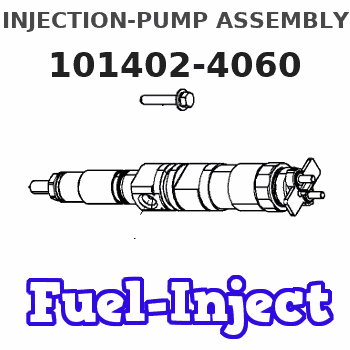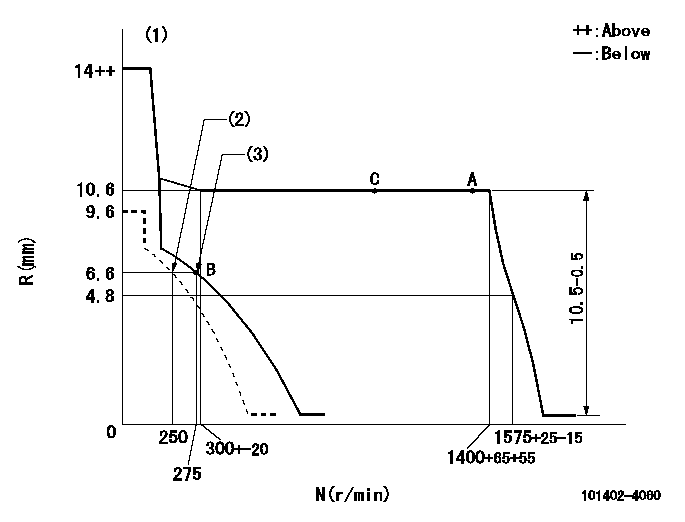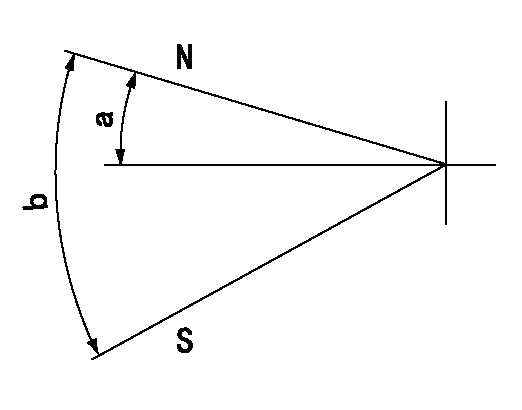Information injection-pump assembly
ZEXEL
101402-4060
1014024060
ISUZU
8943745850
8943745850

Rating:
Service parts 101402-4060 INJECTION-PUMP ASSEMBLY:
1.
_
5.
AUTOM. ADVANCE MECHANIS
6.
COUPLING PLATE
8.
_
9.
_
11.
Nozzle and Holder
8-94339-994-1
12.
Open Pre:MPa(Kqf/cm2)
18.1{185}
15.
NOZZLE SET
Cross reference number
ZEXEL
101402-4060
1014024060
ISUZU
8943745850
8943745850
Zexel num
Bosch num
Firm num
Name
Calibration Data:
Adjustment conditions
Test oil
1404 Test oil ISO4113 or {SAEJ967d}
1404 Test oil ISO4113 or {SAEJ967d}
Test oil temperature
degC
40
40
45
Nozzle and nozzle holder
105780-8140
Bosch type code
EF8511/9A
Nozzle
105780-0000
Bosch type code
DN12SD12T
Nozzle holder
105780-2080
Bosch type code
EF8511/9
Opening pressure
MPa
17.2
Opening pressure
kgf/cm2
175
Injection pipe
Outer diameter - inner diameter - length (mm) mm 6-2-600
Outer diameter - inner diameter - length (mm) mm 6-2-600
Overflow valve
132424-0620
Overflow valve opening pressure
kPa
157
123
191
Overflow valve opening pressure
kgf/cm2
1.6
1.25
1.95
Tester oil delivery pressure
kPa
157
157
157
Tester oil delivery pressure
kgf/cm2
1.6
1.6
1.6
Direction of rotation (viewed from drive side)
Right R
Right R
Injection timing adjustment
Direction of rotation (viewed from drive side)
Right R
Right R
Injection order
1-3-4-2
Pre-stroke
mm
2.9
2.85
2.95
Beginning of injection position
Drive side NO.1
Drive side NO.1
Difference between angles 1
Cal 1-3 deg. 90 89.5 90.5
Cal 1-3 deg. 90 89.5 90.5
Difference between angles 2
Cal 1-4 deg. 180 179.5 180.5
Cal 1-4 deg. 180 179.5 180.5
Difference between angles 3
Cyl.1-2 deg. 270 269.5 270.5
Cyl.1-2 deg. 270 269.5 270.5
Injection quantity adjustment
Adjusting point
A
Rack position
10.6
Pump speed
r/min
1400
1400
1400
Average injection quantity
mm3/st.
114.3
112.8
115.8
Max. variation between cylinders
%
0
-2.5
2.5
Basic
*
Fixing the lever
*
Injection quantity adjustment_02
Adjusting point
B
Rack position
6.6+-0.5
Pump speed
r/min
275
275
275
Average injection quantity
mm3/st.
9.6
8.3
10.9
Max. variation between cylinders
%
0
-14
14
Fixing the rack
*
Test data Ex:
Governor adjustment

N:Pump speed
R:Rack position (mm)
(1)Target notch: K
(2)Set idle sub-spring
(3)Main spring setting
----------
K=10
----------
----------
K=10
----------
Speed control lever angle

F:Full speed
I:Idle
(1)Stopper bolt setting
----------
----------
a=12deg+-5deg b=32deg+-5deg
----------
----------
a=12deg+-5deg b=32deg+-5deg
Stop lever angle

N:Pump normal
S:Stop the pump.
----------
----------
a=12deg+-5deg b=46deg+-5deg
----------
----------
a=12deg+-5deg b=46deg+-5deg
Timing setting

(1)Pump vertical direction
(2)Position of gear mark 'CC' at No 1 cylinder's beginning of injection
(3)B.T.D.C.: aa
(4)-
----------
aa=15deg
----------
a=(95deg)
----------
aa=15deg
----------
a=(95deg)
Information:
There are two operation checks that are fast and need no special equipment. One check is the PULL-DOWN RPM CHECK to see if the BrakeSaver can give full braking force. The other check is the KLUNK CHECK to see if the valve spool in the BrakeSaver control valve has free movement. These two checks give an approximate indication that the BrakeSaver has the correct operation.Pull-Down RPM Check
The engine must give rated horsepower for this test to have accuracy.1. Actuate the brakes, put the transmission in NEUTRAL and operate the engine at high idle rpm (accelerator pedal all the way down).2. Make a record of the engine rpm.3. Put the BrakeSaver control to the full ON position.4. Make a record of the engine rpm with the BrakeSaver full on.5. The engine rpm with the BrakeSaver full on must be 150 25 rpm less than the engine rpm with the BrakeSaver off. If the difference in rpm is less than 125 rpm, the BrakeSaver is not giving full braking force. If the difference in rpm is more than 175 rpm, check the air pressure to the BrakeSaver control valve. The air pressure must not be more than 345 kPa (50 psi).
Do not run the engine at high idle rpm with the BrakeSaver ON for more than 15 seconds at a time. Let the engine run a low idle with the BrakeSaver off for five minutes to keep from getting the engine cooling system too hot.
Klunk Check (check for free movement of the valve spool)
1. Run the engine until the truck air system is at its maximum pressure and then stop the engine.2. Put the BrakeSaver in the full ON position before the air pressure in the truck air system gets below 480 kPa (70 psi).3. Put the BrakeSaver in the OFF position. A noise ("klunk") must be heard at the BrakeSaver control valve as the valve spool hits the cover at the air inlet end of the control valve.4. If the noise is not heard at the BrakeSaver control valve, remove and disassemble the control valve. Inspect the valve for: a. A damaged valve body.b. Damaged or worn springs in the valve spool.c. Damaged or worn valve spool.d. Damaged or worn O-ring seals or diaphragm in the control valve.e. Closed holes (small holes to feel pressure) in the side of the valve spool.For specific problems, make reference to the PROBLEM LIST below.Problem List
1. BrakeSaver does not give full braking force with the mode selector switch in the MANUAL position.2. BrakeSaver does not give full braking force with the mode selector switch in the AUTOMATIC-MANUAL position.3. BrakeSaver Oil temperature is too high.4. BrakeSaver does not turn OFF or become empty.5. Oil leakage from the flywheel housing.6. Oil leakage from the clutch housing or transmission.
Gauge Holes For Troubleshooting
(1) Oil pressure from the BrakeSaver. (2) Oil pressure from the engine. (3) Oil pressure to the BrakeSaver. (4) Test point for BrakeSaver oil temperature. (5) Oil pressure to the engine. (6) Air pressure
The engine must give rated horsepower for this test to have accuracy.1. Actuate the brakes, put the transmission in NEUTRAL and operate the engine at high idle rpm (accelerator pedal all the way down).2. Make a record of the engine rpm.3. Put the BrakeSaver control to the full ON position.4. Make a record of the engine rpm with the BrakeSaver full on.5. The engine rpm with the BrakeSaver full on must be 150 25 rpm less than the engine rpm with the BrakeSaver off. If the difference in rpm is less than 125 rpm, the BrakeSaver is not giving full braking force. If the difference in rpm is more than 175 rpm, check the air pressure to the BrakeSaver control valve. The air pressure must not be more than 345 kPa (50 psi).
Do not run the engine at high idle rpm with the BrakeSaver ON for more than 15 seconds at a time. Let the engine run a low idle with the BrakeSaver off for five minutes to keep from getting the engine cooling system too hot.
Klunk Check (check for free movement of the valve spool)
1. Run the engine until the truck air system is at its maximum pressure and then stop the engine.2. Put the BrakeSaver in the full ON position before the air pressure in the truck air system gets below 480 kPa (70 psi).3. Put the BrakeSaver in the OFF position. A noise ("klunk") must be heard at the BrakeSaver control valve as the valve spool hits the cover at the air inlet end of the control valve.4. If the noise is not heard at the BrakeSaver control valve, remove and disassemble the control valve. Inspect the valve for: a. A damaged valve body.b. Damaged or worn springs in the valve spool.c. Damaged or worn valve spool.d. Damaged or worn O-ring seals or diaphragm in the control valve.e. Closed holes (small holes to feel pressure) in the side of the valve spool.For specific problems, make reference to the PROBLEM LIST below.Problem List
1. BrakeSaver does not give full braking force with the mode selector switch in the MANUAL position.2. BrakeSaver does not give full braking force with the mode selector switch in the AUTOMATIC-MANUAL position.3. BrakeSaver Oil temperature is too high.4. BrakeSaver does not turn OFF or become empty.5. Oil leakage from the flywheel housing.6. Oil leakage from the clutch housing or transmission.
Gauge Holes For Troubleshooting
(1) Oil pressure from the BrakeSaver. (2) Oil pressure from the engine. (3) Oil pressure to the BrakeSaver. (4) Test point for BrakeSaver oil temperature. (5) Oil pressure to the engine. (6) Air pressure